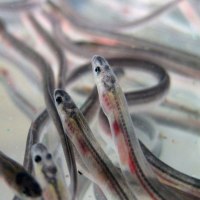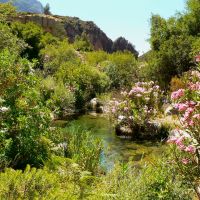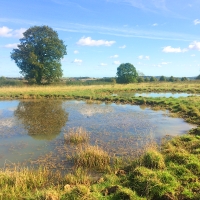Pond creation boosts biodiversity and rare species in agricultural landscapes

Creating pond habitats in farmland can significantly improve landscape biodiversity over relatively short time periods, according to a recently-published study.
Ponds are the most common freshwater habitat – there are an estimated 3 billion worldwide – and often support rich and rare biodiversity. However, they are often overlooked in both environmental policy and management: for example, there is no provision in the European Water Framework Directive to monitor and manage the continent’s 10 million ponds.
Important – but declining – freshwater biodiversity habitats
A 2019 survey by the Freshwater Habitats Trust found declines in freshwater biodiversity in British ponds in protected areas in recent decades. This is significant because these ponds supported more species, and more rare species, than the most biodiverse UK river habitats. Interestingly, the FHT survey suggested that low-level stock grazing around ponds helps suppress the growth of shading scrub woodland on their banks, and so help maintain their biodiversity.
As a result, we can understand pond habitats as an important part of ‘semi-natural’ landscapes where human and non-human natures interact. Accordingly, could creating new ponds in British farmland help increase both the biodiversity and the number of rare species that these landscapes support?
This is a key question underpinning the new study, funded by the Environment Agency, and recently published in the journal Biological Conservation. Its authors studied the ecological impacts of the creation of ‘clean water’ ponds in farmland in the Midlands of England over a nine-year period. Clean water ponds are habitats which are not connected to streams or ditches, and are filled with unpolluted surface- and ground-water.

Pond creation significantly increases biodiversity in agricultural landscapes
The project team found that creating twenty such ponds across a 10km² area of farmland increased the number of wetland plant species by more than a quarter (26%), and almost trebled the number of regionally rare plants (a 181% increase) over a five year period. The results suggest that pond creation can stem, or even reverse, the loss of biodiversity – particularly of plant species – in agricultural landscapes over a relatively short timescale.
Lead author Penny Williams from the Freshwater Habitats Trust says, “The gains we saw are unprecedented for freshwater and are, by a long way, the largest recorded improvements in freshwater diversity seen from adding land management measures to countryside landscapes.
“Our previous work had already shown that ponds were a secret treasure in the British countryside – with a value out of proportion to their tiny size – however the scale of benefits from adding new ponds took all of us by surprise,” Williams continues.
The study is the first major result from the Water Friendly Farming project: a long-term collaboration between the Freshwater Habitats Trust, Game & Wildlife Conservation Trust, the University of York, the Environment Agency and landowners in three Leicestershire catchments.
Dr Jeremy Biggs, the Director of the Freshwater Habitats Trust, says, “This is such an important result: freshwater biodiversity is under threat both across the UK and the globe. Climate change will wreak even more havoc in future years and up to now we have found very few ways to combat losses and make the countryside more resilient.
Biggs adds, “This study is unique because we’ve proven that it’s possible to increase freshwater biodiversity significantly at a regional scale. Up to now benefits have either been very limited, or very local.”

Ponds increase biodiversity and rare species more than other measures
The project team also tested a number of other management measures in their study catchments, such as adding woody debris to streams, damming ditches to ‘slow the flow’ and trap sediment, and building interception ponds which filtered nutrients and pollutants.
These measures helped stem background plant biodiversity loss (roughly 1% per year), but did not help rare species return to the landscape. Pond creation is shown to have significant biodiversity benefits, whilst remaining cost-effective – each pond cost between £1500-2000 to create.
Prof Chris Stoate from the Game and Wildlife Conservation Trust says, “It’s clear that the key ingredient to success was carefully locating new ponds in places where they would fill with clean water. To get the best effect we sited them in low intensity pasture, scrub or woodland – areas unaffected by agricultural or road pollution. Measures in other locations and with other functions didn’t work half so well.”
The study is the first demonstration of a whole-landscape increase in freshwater biodiversity as a result of management measures in agricultural landscapes. It shows that pond habitat creation can have a positive effect on catchment biodiversity over a relatively short period of time. As a result, the authors emphasise the potential for ‘clean water’ pond creation to help stem, or even reverse, biodiversity loss in agricultural landscapes.
+++
Read a briefing note for policy makers and environmental managers on the study findings.















Comments are closed.